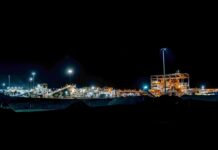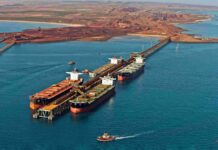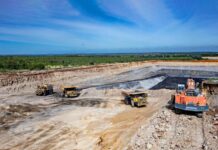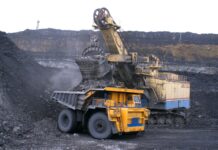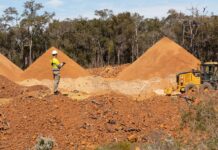Aussie safe cleaning
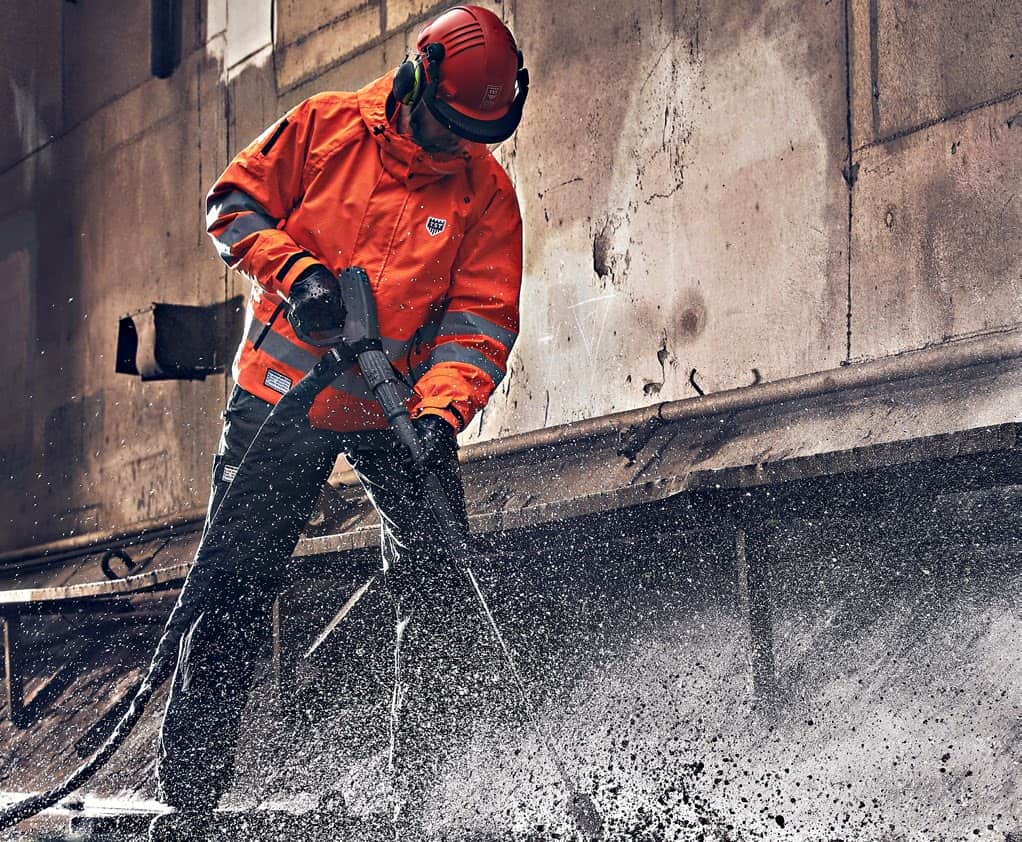
Stay safe … not sorry
This story is contributed by Australian Pump Industries (Aussie Pumps).
Their focus is on designing and building high pressure cleaners in both hot and cold water configurations. The family owned company has a philosophy of working with the mining industry towards providing high pressure cleaning equipment machines that are easy to service, highly effective but more importantly safe to use.
“Cleaning mining equipment is a dirty job”, said Aussie Pumps Chief Engineer, John Hales. “Mining plant service and maintenance depends on the cleanliness of the equipment, whether it’s surface or underground gear.
At Aussie Pumps we focus on designing machines that are mine proof but have a capability that’s second to none with a focus on safety and all it’s dimensions”, he said.
Australia’s mining industry recognises that using high pressure cleaning equipment is essential for maintenance.
It’s also well known that this equipment, built around high pressure positive displacement triplex style pressure pumps, can be dangerous if operators are not suitably trained and machines not regularly serviced and maintained.
Minimising breakdowns by preventative maintenance is recognised as an essential part of the industry.
“High pressure cleaning of equipment can reveal service issues that otherwise would not be obvious. Here, we work through the current situation in terms of regulations, safety standards and safety training program produced by Australian Pump. It’s already available on a free of charge basis to operators, not just in Australia, but right through the South Pacific”, said Hales.
Aussie’s safe operator program
The Safe Operator Program is a recognition by Australian Pump that in spite of building safety factors into the equipment, accidents can and will still happen. Operators should be properly trained and equipment must be kept in good condition.
The company’s ‘Mine Boss’ pressure cleaner range extends all the way from 200 bar pressure rating all the way to 500 bar (7,300 psi). They believe that training for operators should extend right through that range, not just in the higher pressure rated equipment.
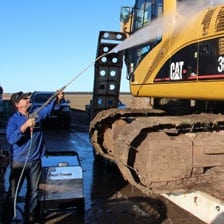
“Our Safe Operator” training program is designed to keep operators, and by standers safe from injury. It explains firstly how the equipment works, then moves on onto the essentials of machine safe operation”, said Hales.
Safety standards … A or B?
Australian Pump recommend mines operating high pressure equipment should familiarise themselves with Australian Standards AS/NZS:4233.01. The Standards classify machines into Class A and Class B.
High pressure water blasters are classified based on their pressure and flow combined. The Standards Association set a breakpoint between A and B at 5,600 bar/litres.
That means the pressure of the machine in bar multiplied by the litres per minute flow. Thus, a 5,000 psi (350 bar) machine operating with a flow of 20 lpm is a 7,000 bar/litre machine. As such, it is classified as Class B with a different set of mandated requirements that mining companies should be made aware of.
Conversely, a 5,000 psi (350 bar) machine with 16 lpm flow is a Class A machine and therefore does not require the same level of certification.
Below we will explain the difference between A and B class, not just in pressure but also the requirements of the Standards designed to keep operators safe.
Class A operators
Based on the Standards, Class A operators must be trained and competent in identifying hazards, assessing and controlling the risks and using safe working procedures (see Aussie’s free Safe Operator program.)

They must also be familiar with the operation of Class A machines and use suitable PPE. They must be trained to carry out daily checks on equipment to identify issues before they become dangerous, ie worn high pressure hoses, leaking couplings and worn nozzles.
Aussie Pumps Class A Operator Training Program is designed to maintain operator competency and safety awareness. It is recommended to undertake a refresher course every two years. The training course is now recommend by many TAFE’s and other training bodies.
Class B operators
Class B machines, over 5,600 bar/litres, have a different set of rules as outlined below.
Operators must be RTO certified and accessed as competent in identifying hazards, assessing and controlling the risks and using safe working procedures.
They must carry verification of competency, and must maintain competency through refresher training course every two years.
They must be familiar with the operation of Class B machines and use suitable PPE. They must carry out daily inspections of the equipment to identify and rectify any potential issues before use.
Operators without certification
Work insurance may be invalid and injury compensation claims denied.
Access maybe denied to commercial or industrial worksites, specifically mine sites.
To summarise, you can see there is a major difference between Class A and B machines in terms of operator training and requirements. There are highly competent trainers, working under the banner of an RTO, who deliver Class B courses. They can be expensive but under the circumstances and depending on the size of the equipment, well worth the money.
High pressure pump systems … how they work
The heart of Aussie’s Mine Boss pressure cleaner range is a ‘Big Berty’ Bertolini pump. Australian Pump chose Bertolini over other brands because of the gearbox drive with a 2:1 reduction that allows the big pumps to achieve their performance running at only 1450 rpm.
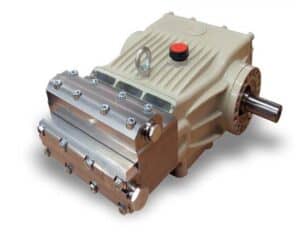
That slow speed substantially adds to the life of the pump, with a totally enclosed drive that is regarded as being significantly better than outdated belt and pulley systems.
The pumps also feature advanced designs that include an intelligent packing seal system, valve caps designed to eliminate the water pressure in the threads and a double cast crankcase with fins for operational cooling.
Choosing the right pump and maintaining it properly is a great way to ensure reliable operation and, ultimately, substantially lower operating costs.
Aussie safety protection kit
All of the machines produced by Australian Pump are fitted with ASP. The ASP kit consists of not only the standard pressure relief valve but also a safety valve that discharges to atmosphere if a pressure spike occurs. Those spikes are generated often by jammed unloaders, or machines with the pressure relief valve wound down to achieve higher pressures than the machine is designed to produce can never be used. Pressure spikes can be dangerous, the safety valve is regarded as an essential component.
The kit also includes a thermal dump valve that discharges if the temperature of water in the pump rises too high. That protects the seals and pistons in the pump. Rising temperature can occur if the machine is left on bypass running for an extended period. Running the pump on extended bypass is not recommended.
Nozzle selection
Nozzles need to be sized precisely to suit the combination of flow and pressure. Aussie’s Nozzle Selection Guide shows how the operator can select the right sized orifice in the Aussie Laser Tip nozzle. Correct nozzle size is essential for the machine to provide the best performance.
Nozzles do wear! If the pressure reading on the pressure gauge shows a drop below the preset pressure, for example, 4,000 psi, dropping to 3,800 it could indicate a worn nozzle. The remedy would be to replace the nozzle, restoring the pump to it’s proper performance level.
Continuing to operate with worn nozzles, is dangerous. An oversize nozzle could generate a spike if the unloader is not being suitably lubricated by bypass liquid. If all of the liquid produced by the pump is going through the nozzle, there is no lubricating/cooling function taking place in the unloader valve. Operators should check the nozzle as part of their daily check of machine.
Choose the right gun
The pistol grip on the gun itself must be compatible to the triplex pump on the machine. Using faulty, worn or damaged guns is dangerous!
Class A machines with faulty guns are just as dangerous as Class B machines with the same issue.
Using a handheld gun for high pressure water blasting is risky. Gloves should be worn along with other PPE equipment as part of Aussie’s TST range of safety clothing.
High pressure hose, extreme care required
“We’ve seen high pressure operators using hoses up to 500 bar where the outer covering is worn and the wire braid is severely damaged. Aussie Pumps ‘Blue Pro’ high pressure hose is suitable for both Class A and B machines within that category of 5,000 psi or less” said Hales.
For higher pressure ratings, for example, 500 bar Aussie supplies top quality European 500 bar hose as part of the ‘Ultra‘ red hose line. These are colour coded red to differentiate from the standard Blue Pro product.
Caring for hose assemblies
The most dangerous part of the machine can be the hose. Here is what to look out for;
- Hose assemblies unnecessarily subjected to frequent and long periods of high pressure.
- Exposure to higher temperatures that the hose is rated for, normally in excess of 150 degrees C.
- Longitudinal stress caused by repetitive and prolonged use of hose assemblies in a long line function applications or long vertical drops.
- Beware of unnecessary exposure to sharp, protruding and abrasive surfaces. Dragging hose assemblies across concrete or “sharps” must be avoided.
- When hose assemblies are worn, replace them immediately.
Hose shrouds or restraints
Aussie’s TST hose shrouds are placed on the hose at the connection to the gun. This provides effective protection for the operator as the shroud material, Dyneema, is claimed to be the world’s strongest fibre. Correctly mounted on the gun, it provides effective protection for the operator and has been tested for up to 500 bar.
An option to the hose shroud is Aussie’s range of hose restraints which they fit to all Class B machines. Hose ruptures account for 90% of operator injuries!
PPE … Stay safe
To minimise risk to health and safety, personal protection equipment should be provided.
Aussie’s TST safety clothing equipment provides the following;
- Is suitable for having regard to the nature of the work and the hazards associated with the work.
- Is suitable for size and fit and reasonably comfortable for the worker.
- It should be maintained, repaired or replaced so it continues to minimise the risk.
- It should be cleaned, hygienic and in good working order.
The range includes head protection, complying with AS/NZS 1801:1997, occupational protective helmets should be worn. Eye protection is also part of the kit with the visor in compliance with AS/NZS 1337:2010 and should be worn by operators where high pressure blasting is taking place. The worker should as a minimum wear safety glasses and a face shield in compliance with AS/NZS 1337.
Leg & body protection
Workers should wear waterproof protective clothing, complying with AS:NZS 3765.1-1990. That is clothing for protection against hazardous chemicals, protection against general or specific chemicals.
Hand protection
Complying with the recommendations of AS/NZS 2161.2:2005, occupational protective gloves in Dyneema will protect against mechanical risks and may also protect against cold where a risk assessment indicates that it is required.
Foot and lower leg protection
Workers should wear protective footwear complying with AS/NZS 2210.3:2009. TST safety footwear provides boots, designed for comfort, performance and grip. They are completely vulcanised rubber boots fitted with steel toe caps and sole inserts.
Black areas on uppers indicate areas that will withstand high pressure water jets up to 500 bar. See QR code.
They feature adjustable top strap, are waterproof, have a textile inner lining for comfort and are easy to pull on. Available in sizes from 36 to 48.
Personal hearing protection
Where noise can’t be eliminated or minimised, practicable personal hearing protectors are available as well as instruction and training in their use. These can be used in combination with the TST helmet and visor for extra protection.
Free safety training course
Aussie’s Safe Operator free training program can be done online with hundreds of people having undertaken the course already. A parallel training course covering high pressure Jetting is also readily available from Australian Pump Industries. See QR code below for the courses. Please note that the courses are absolutely free but may not be appropriate for Class B operators as Aussie is not RTO certified.
Be safe … not sorry
Scan here for more info on Aussie’s safe operator training program






